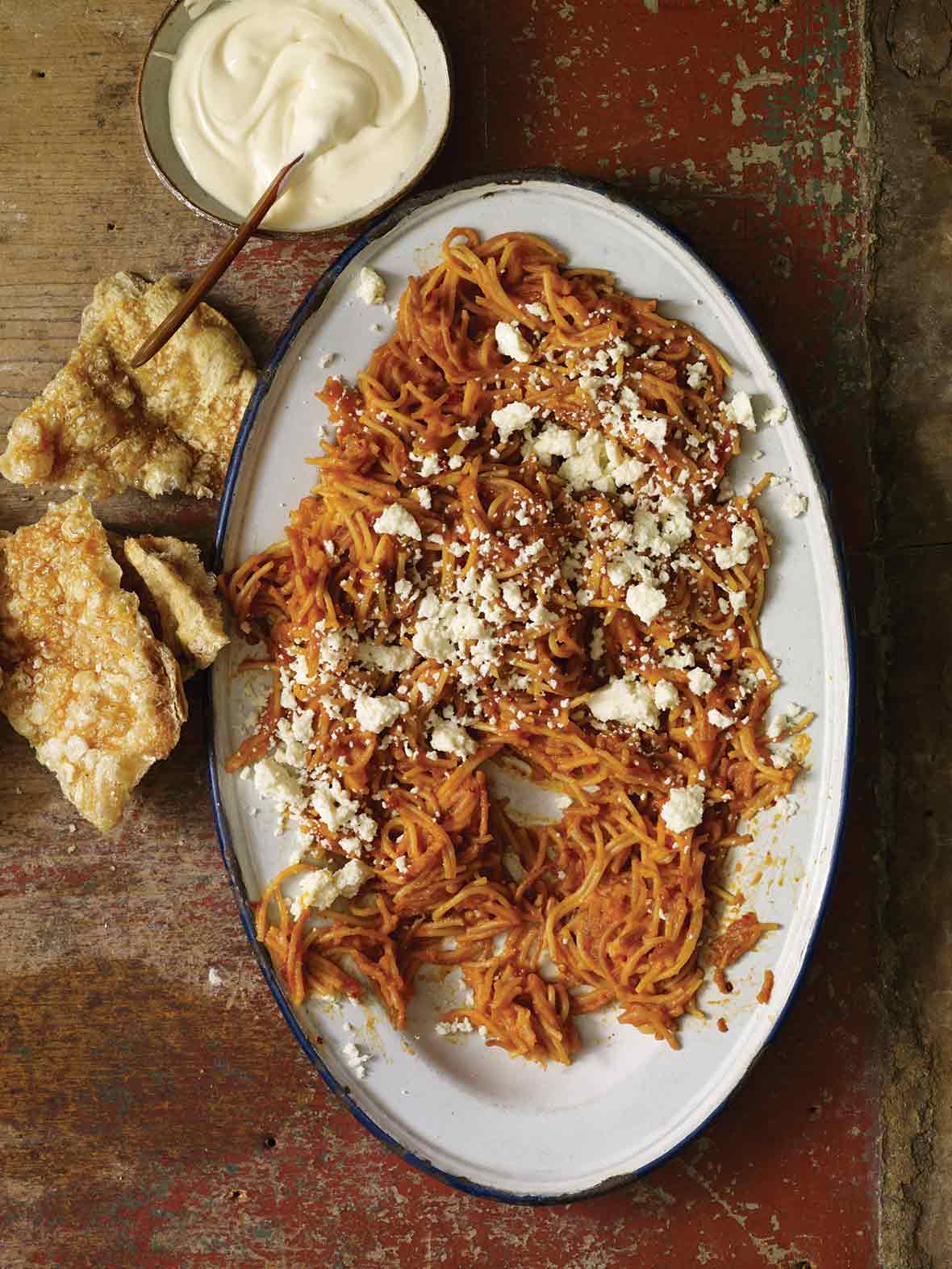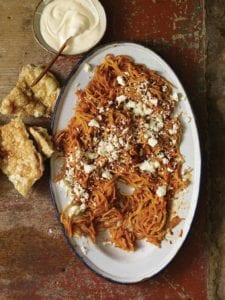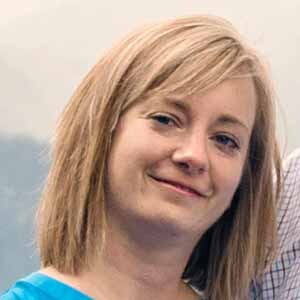
Commonly dubbed “Mexican spaghetti,” sopa seca de fideo is a traditional Mexican dish made by lightly frying thin noodles in oil to lend the dish a toasted flavor before smothering the noodles in a chipotle-spiked tomato sauce. (Actually, the chipotle isn’t always included, although frankly we can’t imagine this plate of noodles being anywhere near as compelling without it.) Though the noodles are traditionally served as a first course, we don’t think we can show enough restraint to not demolish a main course serving. Plain pasta with simple tomato sauce just met some serious competition.–Angie Zoobkoff
Are fideo noodles the same as spaghetti?
Fideo noodles are slender pasta strands similar to vermicelli or angel hair pasta. In Mexico City, they come in various sizes with the most common length about 1 inch. You’ll find fideo noodles at Mexican grocery stores or in the Hispanic foods aisle of some mainstream grocery stores. You can substitute vermicelli or angel hair pasta broken into whatever size lengths your recipe requires or you desire.

Mexican Spaghetti ~ Sopa Seca de Fideo
Ingredients
For the fideo noodles
- 6 (about 1 1/2 lbs) ripe plum tomatoes
- 2 cloves garlic, peeled
- 1/4 medium onion
- 2 tablespoons minced canned chipotles en adobo plus 1 teaspoon adobo sauce
- 1/2 teaspoon brown sugar or grated piloncillo
- 3 tablespoons mild vegetable oil
- One (12-ounce) package fideo noodles*, vermicelli, or angel hair pasta, broken into 3-inch (8-cm) lengths
- 1/2 teaspoon kosher salt, plus more to taste
To garnish and serve
- 1/2 cup store-bought or homemade crema (or substitute equal parts sour cream and heavy cream with a pinch of salt)
- 1 scant cup crumbled queso fresco
- 1 ripe Haas avocado, peeled, pitted, and thinly sliced (optional)
- Chicharrón (pork cracklings) (optional)
Instructions
Make the fideo noodles
- Fill a medium saucepan 2/3 full with water and add the tomatoes. Bring to a gentle simmer over medium heat and cook until the tomatoes are softened, 7 to 10 minutes. The skins may split before the tomatoes are softened and that’s okay, just reduce the heat to low. Use a slotted spoon to transfer the tomatoes to a small bowl and let them cool for a few minutes. Reserve the pot of cooking water.
- When the tomatoes have cooled, use your fingertips to slip off the skins as you hold each tomato over the bowl. (They’ll slip off quite easily.) Add the peeled tomatoes, along with any juices left in the bowl, to a blender along with the garlic, onion, and 1/2 cup reserved cooking water. Blend on high until very smooth, 2 to 3 minutes.
- In a small bowl, mix together the minced chipotle, adobo sauce, and brown sugar or grated piloncillo.
- Add 1 tablespoon oil to a large skillet set over medium heat. (We recommend using the deepest, widest skillet you have as the fideo noodles like to jump out of the pan!) When the oil is hot, scatter half the noodles in the pan, stirring almost constantly and reducing the heat if they brown too quickly, until the noodles are a deep golden brown, 4 to 6 minutes. Move to paper towels to drain. Wipe out the pan and repeat with 1 more tablespoon oil and the remaining noodles.
- Wipe the pan clean once more and heat the remaining 1 tablespoon oil over medium to medium-low heat. When the oil is hot, carefully pour in the tomato purée (stand back as it may splatter) and salt and cook, stirring occasionally, until the sauce no longer tastes of raw onion and garlic, 5 to 8 minutes. Stir in the chipotle paste and taste for seasoning. (Canned chipotle en adobo can vary in acidity, depending on the brand. Make sure to taste and, if desired, add a little more sugar or adobo sauce to make it sweeter or hotter.)
- Add the fried noodles and cook over medium-low heat until they absorb nearly all the sauce, 3 to 5 minutes. Add 1/2 cup reserved cooking water from the tomatoes and cook until all the liquid is absorbed and the noodles are al dente, about 3 minutes longer. Taste the noodles—if they’re still too crunchy or chewy for your taste, add more of the reserved cooking water in 1/4 cup increments, allowing the liquid to absorb the liquid before adding more.
Garnish and serve
- Divide the fideo noodles and sauce among plates and pass the crema, crumbled cheese, avocado slices, and chicharrón, if using, on the side.

Nutrition
Nutrition information is automatically calculated, so should only be used as an approximation.
Recipe Testers’ Reviews
Sopas secas (dry soups) are a class of Mexican dish typically served as a first course. The sopa seca we are most familiar with in the U.S. is the ubiquitous red rice served at every Mexican restaurant. But sopas secas can also be made with other ingredients, such as pasta or tamales, and sopa seca de fideos, made with short pieces of extremely fine pasta, is a classic.
Use the chipotle, if you like, or leave it out for a milder dish. If you use it, as I did, the avocado garnish makes a nice cool counterpoint to the heat. I used gluten-free fideos (from the Harisín line made by Sanaví in Spain), so others’ results might differ, but I had no problem with them burning while frying and found the timing for cooking the pasta in the sauce to be accurate. I did add some additional water (1/2 cup), as the sauce started to dry out before the noodles were done.
I had put the meal on the table and was still racing around taking care of a few last things before commencing to eat. As I reentered the dining room, before I had even sat down, my husband greeted me with, “This is a Tester’s Choice.” And he was correct.
The chipotles (it took four canned chiles to get me the 2 tablespoons minced) provided a base layer of heat that was discernible but not intrusive. The noodles (I did need the additional 1/2 cup water) cooked perfectly in the sauce and had a lovely texture.
My only gripe with the recipe is the difficulty of taking the last of the fried noodles out of the pan to wipe it down. It took as long to get a batch of noodles out of the pan onto paper towels as it did to cook them. I don’t know how to make this any easier without using 3 separate skillets. I’d imagine that making this repeatedly would make it a bit quicker and easier to prepare. I guess I’ll find out!
It never fails to amaze me how the addition of a couple simple ingredients can elevate a dish to so much more than it appears to be. At first glance, this looked like a twist on noodles in tomato sauce. In the end, it was the best thing I’ve eaten in weeks. The addition of chipotles adds a smokiness that completely elevates the dish, and then the crema and cheese on top perfectly balance it all. We actually argued over who would get to have the leftovers.
I didn’t need to adjust the sugar after adding the chipotles. After adding the noodles, the sauce was completely absorbed after 4 minutes, but the noodles were still VERY crunchy. I added 1/2 cup cooking liquid, which was absorbed after 2 minutes, and the noodles were still not al dente. I added another 1/4 cup and after 1 more minute they were perfect. I served this as a main dish with all the suggested toppings. I served it with a Mexican kale salad with cumin-lime vinaigrette.
This is a delicious Mexican noodle dish. The spice level was perfect for the whole family although I may have enjoyed even more chipotle spiciness. This dish took me back to my childhood when my family would eat at a local (Arizona) Mexican restaurant that would serve fideo and refried beans in place of the rice and beans as a side dish on the combination plates.
I think the dish was a tad bit greasy. Maybe a total of 1 1/2 tablespoons of oil for the entire dish rather than 3 tablespoons would have sufficed. I used two 7-ounce packets of the fideo noodles. This is the only size they came in at all nearby stores. I used feta cheese rather than the queso fresco and sour cream mixed with cream rather than Mexican crema. I think it would be magnificent topped with a Mexican pulled pork that I make with cilantro sprinkled on top.
I’ve previously known this dish as a more soupy dry soup, and this was my first pass at the fideo noodles as a truly dry soup. This version has an enticing combination of carbs and spices and a truly-can’t-stop-eating-it deliciousness!
This recipe has nearly the perfect spiciness; it could be just a tad spicier for my personal taste. As it was, the spice lingered for a moment, then dissipated. I additionally think it could go a little spicier because the trio of garnishes (crema, avocado, and queso fresco) all work to calm any amount of heat. Heat or no heat, the noodles themselves are addictive and one serving easily leads to another.
I added no additional salt, since I anticipated that the crema and cheese garnishes would add plenty of salt for my taste, as well as that of my tasters, and I was correct here. I used the full avocado rather than half since a half seemed skimpy when divided out into individual servings. It seemed like a lot of oil but the end product wasn’t greasy or oily.















I have lived in Mexico for the last 40+ years and am I professional food writer here. The article about fideos, as well as a comment or two, mention that sopa seca is served as a meal’s first course. In fact, sopa seca is always the SECOND course of a full comida (the main meal of the day in Mexico), following sopa aguada (liquid soup) and preceding the main course.
Thank you, Cristina, for that clarification.
The comments on your recipes are as useful as the recipes themselves. I had never heard of piloncillo but it was easy enough to find out it that it is pure cane sugar. I have also never encountered fideo but some of the alternates suggested are in my pantry. I have pinned this recipe with a note to read the comments. I never can tell what comment might turn a recipe from a disaster to dinner!
So glad you find the comments to be useful, MPaula! Thanks so much for taking the time to let us know.